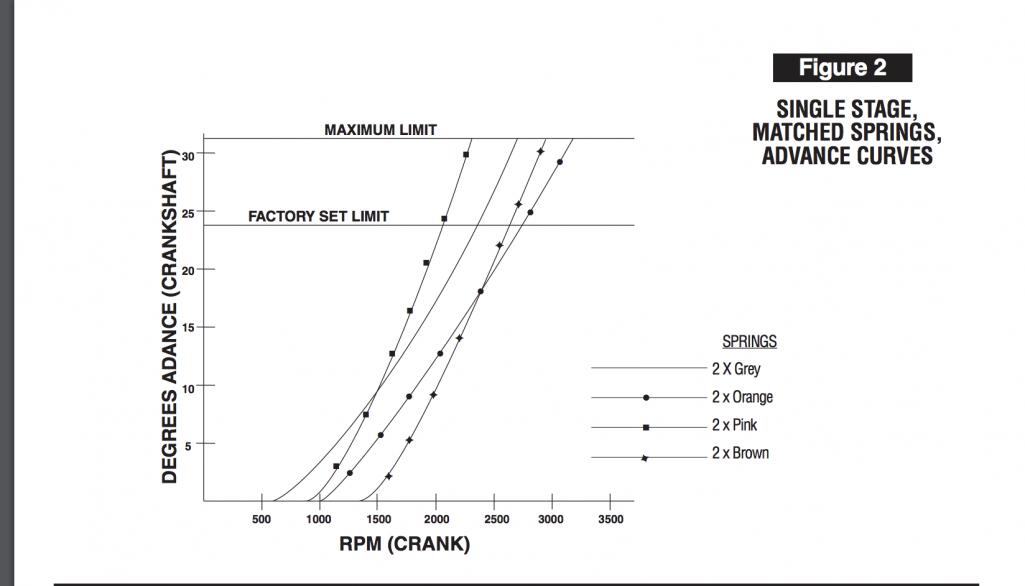|
|

|
Porsche, and the Porsche crest are registered trademarks of Dr. Ing. h.c. F. Porsche AG.
This site is not affiliated with Porsche in any way. Its only purpose is to provide an online forum for car enthusiasts. All other trademarks are property of their respective owners. |
|
|
  |
| Mblizzard |
 Nov 16 2017, 02:03 PM Nov 16 2017, 02:03 PM
Post
#1
|
|
Advanced Member     Group: Members Posts: 3,033 Joined: 28-January 13 From: Knoxville Tn Member No.: 15,438 Region Association: South East States |
I have converted my 2.0 to a 2056 and added Micro Squirt fuel injection.
Ever since I did the 2056 conversion I have seen higher than norm cylinder head temperatures. In fact I cracked a set of heads from getting them too hot. I played around with the timing with in the suggested 2.0 limits of around 27 degrees. but was really never able to influence the CHTs that much with changes in the timing. Adding more fuel at the right times with the Micro Squirt certainly allowed me to control the CHT much better but I always felt it was still getting too high. Then I ran across this. 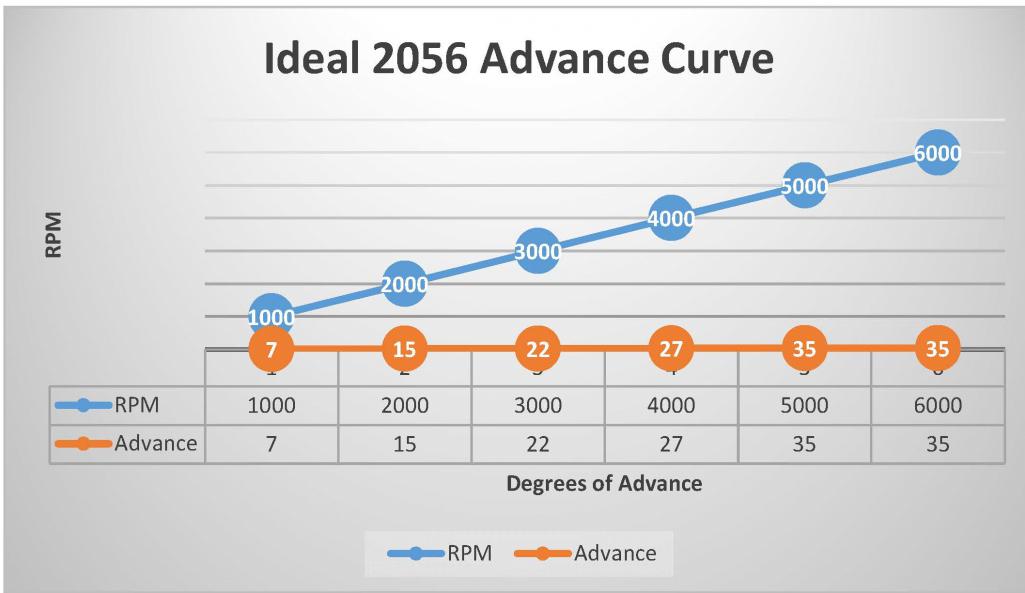 This is certainly a lot more advance than I ever added to the engine. So based on that I revised my timing table to: 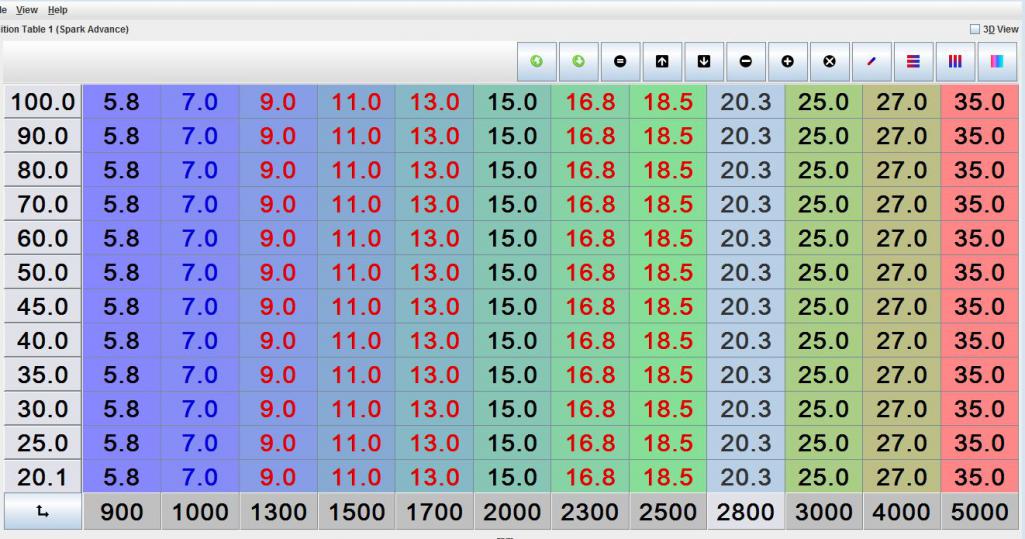 Just love how easy it is to make changes with Micro Squirt. So I am looking to see what the thoughts are on 35 degrees of advance and what impacts it may have on CHT. I am going to load this and test tomorrow. |
| yeahmag |
 Nov 17 2017, 12:50 PM Nov 17 2017, 12:50 PM
Post
#2
|
|
Advanced Member     Group: Members Posts: 2,442 Joined: 18-April 05 From: Pasadena, CA Member No.: 3,946 Region Association: Southern California 
|
|
| JamesM |
 Nov 17 2017, 02:56 PM Nov 17 2017, 02:56 PM
Post
#3
|
|
Senior Member    Group: Members Posts: 1,992 Joined: 6-April 06 From: Kearns, UT Member No.: 5,834 Region Association: Intermountain Region |
Mike,
Is there specific RPM/Load point on your map where you notice the overheating the most? If so what what is the range (RPM and load) and what do your advance and AFR numbers currently look like there? What RPM range are you normally cruising at? Curious where that recommended advance cure you posted came from as I have not seen number like that suggested before for a type 4 (though i have for a type 1). The timing table I use was based on a compilation of previously shared data (most of it dyno testing from Jake Raby) that shows you want full advance to come in by 3000 RPM and that max advance is best right around 28deg. Based on what I run the table you posted is slightly retarded from idle pretty much all the way to 4k RPM which i suspect may cause you to run slightly hotter. Also, what sort of head temps are we talking here? As I recall you mentioned you are running a stock cam and those are known to just run hot. I have a perfectly tuned (passes emissions every time) stock cam 2.0L car that usually runs in the 350-380 range but under extended periods of load can get near the low 400s where as my warmed over 2056 megasquirt car with modified cam rarely even sees 350. I would expect a stock cam 2056 would be pushing near 400 pretty often even when dialed in. Not sure there is much you will be able to do about it other than change the cam. Ill go grab the timing map off my laptop and post it here in a bit. I have converted my 2.0 to a 2056 and added Micro Squirt fuel injection. Ever since I did the 2056 conversion I have seen higher than norm cylinder head temperatures. In fact I cracked a set of heads from getting them too hot. I played around with the timing with in the suggested 2.0 limits of around 27 degrees. but was really never able to influence the CHTs that much with changes in the timing. Adding more fuel at the right times with the Micro Squirt certainly allowed me to control the CHT much better but I always felt it was still getting too high. Then I ran across this.  This is certainly a lot more advance than I ever added to the engine. So based on that I revised my timing table to:  Just love how easy it is to make changes with Micro Squirt. So I am looking to see what the thoughts are on 35 degrees of advance and what impacts it may have on CHT. I am going to load this and test tomorrow. |
| JamesM |
 Nov 17 2017, 03:09 PM Nov 17 2017, 03:09 PM
Post
#4
|
|
Senior Member    Group: Members Posts: 1,992 Joined: 6-April 06 From: Kearns, UT Member No.: 5,834 Region Association: Intermountain Region |
This is the table I run on my 2056. It gives very snappy response and even on a hot Utah day the heads are usually under 350 deg. I setup a similar table with a slightly less aggressive ramp up before 3000 rpm (as its not my motor to blow up) on my buddies monster 2270 and it runs just as cool at the heads. Bottom line the majority of your driving time is going to be spent between 3000 and 5000 rpm and that range should always be 27-28 deg advance and somewhere in the 13s afr on cruise and 12 on load. If you are hitting those numbers and still running hot you probably need to look elsewhere to run cooler.
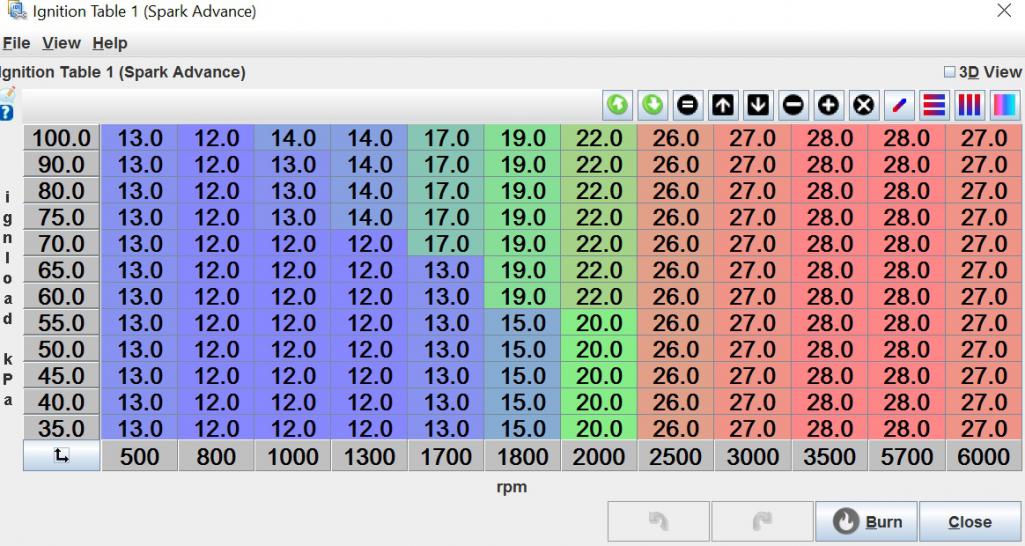 |
| Mblizzard |
 Nov 21 2017, 03:40 PM Nov 21 2017, 03:40 PM
Post
#5
|
|
Advanced Member     Group: Members Posts: 3,033 Joined: 28-January 13 From: Knoxville Tn Member No.: 15,438 Region Association: South East States |
Mike, Is there specific RPM/Load point on your map where you notice the overheating the most? If so what what is the range (RPM and load) and what do your advance and AFR numbers currently look like there? What RPM range are you normally cruising at? Curious where that recommended advance cure you posted came from as I have not seen number like that suggested before for a type 4 (though i have for a type 1). The timing table I use was based on a compilation of previously shared data (most of it dyno testing from Jake Raby) that shows you want full advance to come in by 3000 RPM and that max advance is best right around 28deg. Based on what I run the table you posted is slightly retarded from idle pretty much all the way to 4k RPM which i suspect may cause you to run slightly hotter. Also, what sort of head temps are we talking here? As I recall you mentioned you are running a stock cam and those are known to just run hot. I have a perfectly tuned (passes emissions every time) stock cam 2.0L car that usually runs in the 350-380 range but under extended periods of load can get near the low 400s where as my warmed over 2056 megasquirt car with modified cam rarely even sees 350. I would expect a stock cam 2056 would be pushing near 400 pretty often even when dialed in. Not sure there is much you will be able to do about it other than change the cam. Ill go grab the timing map off my laptop and post it here in a bit. I have converted my 2.0 to a 2056 and added Micro Squirt fuel injection. Ever since I did the 2056 conversion I have seen higher than norm cylinder head temperatures. In fact I cracked a set of heads from getting them too hot. I played around with the timing with in the suggested 2.0 limits of around 27 degrees. but was really never able to influence the CHTs that much with changes in the timing. Adding more fuel at the right times with the Micro Squirt certainly allowed me to control the CHT much better but I always felt it was still getting too high. Then I ran across this.  This is certainly a lot more advance than I ever added to the engine. So based on that I revised my timing table to:  Just love how easy it is to make changes with Micro Squirt. So I am looking to see what the thoughts are on 35 degrees of advance and what impacts it may have on CHT. I am going to load this and test tomorrow. I found this is a couple of different locations that I will track down the sources. But this is another one of them that specifically references the Type 4. 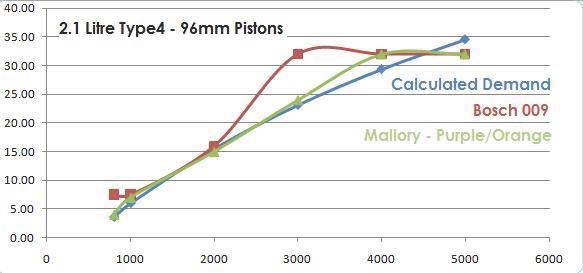 I got no attachment to this table and like you it was something well outside of what I knew about the Type 4. I was previously running your table. At highway speeds 70+ the engine always ran at 350 or higher unless the AFR was set in the 12s. Under load going up a hill temps could reach 400. Pretty sure the cooler winter temps have a huge impact on the temps that have nothing to do with the timing change. But with the new table they seem to stay in the 360 range on the hill climbs on my standard route to work. Change it to summer temps and I am betting I see similar temps or higher with the new table. I am like you moving toward the cam as the issue. |
| Mblizzard |
 Nov 22 2017, 10:20 AM Nov 22 2017, 10:20 AM
Post
#6
|
|
Advanced Member     Group: Members Posts: 3,033 Joined: 28-January 13 From: Knoxville Tn Member No.: 15,438 Region Association: South East States |
|
| VaccaRabite |
 Nov 22 2017, 10:57 AM Nov 22 2017, 10:57 AM
Post
#7
|
|
En Garde!           Group: Admin Posts: 13,589 Joined: 15-December 03 From: Dallastown, PA Member No.: 1,435 Region Association: MidAtlantic Region |
I got no attachment to this table and like you it was something well outside of what I knew about the Type 4. I was previously running your table. At highway speeds 70+ the engine always ran at 350 or higher unless the AFR was set in the 12s. Under load going up a hill temps could reach 400. Your engine sounds a LOT like mine. My heads always ran hot, 350+ in 5th gear on the freeway, 370-380 was a normal cruising temp, and any hills on the freeway I just climbed them in 4th to keep as much air flowing as possible. What cam is in your engine? I have yet to really run my engine since redoing the heads and adding Microsquirt, so I don't know what my current heads are like. And I got my head temp from under the #3 spark plug, which is the hottest. But it always ran hot. Zach |
| Mblizzard |
 Nov 22 2017, 11:13 AM Nov 22 2017, 11:13 AM
Post
#8
|
|
Advanced Member     Group: Members Posts: 3,033 Joined: 28-January 13 From: Knoxville Tn Member No.: 15,438 Region Association: South East States |
I got no attachment to this table and like you it was something well outside of what I knew about the Type 4. I was previously running your table. At highway speeds 70+ the engine always ran at 350 or higher unless the AFR was set in the 12s. Under load going up a hill temps could reach 400. Your engine sounds a LOT like mine. My heads always ran hot, 350+ in 5th gear on the freeway, 370-380 was a normal cruising temp, and any hills on the freeway I just climbed them in 4th to keep as much air flowing as possible. What cam is in your engine? I have yet to really run my engine since redoing the heads and adding Microsquirt, so I don't know what my current heads are like. And I got my head temp from under the #3 spark plug, which is the hottest. But it always ran hot. Zach Stock cam. Sounds like we have pretty much the same set up. I am using new high impedance injectors. James likely hit on the issues as it is well known with the stock cam. But I use a cheap android tablet and MSDroid to adjust on the fly at times. You can add more fuel under the high load situations with the stock cam and keep the temps down. With the tablet it is easy to see where the VE and MAP are on the climbs and add some fuel there as needed. I actually have a very rich fuel table that I have in a hill climb tune on the tablet. Pretty easy to load it and go. But still looking toward a new cam. |
| McMark |
 Nov 22 2017, 12:54 PM Nov 22 2017, 12:54 PM
Post
#9
|
|
914 Freak!                Group: Retired Admin Posts: 20,179 Joined: 13-March 03 From: Grand Rapids, MI Member No.: 419 Region Association: None |
I would ensure the timing accuracy -- make sure your timing light is matching exactly with the computer.
The fact that it idles well with half the normal timing seems like something isn't matched up. I can't get an engine to idle for shit with 7° at idle. |
| Mblizzard |
 Nov 22 2017, 03:21 PM Nov 22 2017, 03:21 PM
Post
#10
|
|
Advanced Member     Group: Members Posts: 3,033 Joined: 28-January 13 From: Knoxville Tn Member No.: 15,438 Region Association: South East States |
I would ensure the timing accuracy -- make sure your timing light is matching exactly with the computer. The fact that it idles well with half the normal timing seems like something isn't matched up. I can't get an engine to idle for shit with 7° at idle. I get perfect alignment of timing at a 72 degree offest angle. But as you stated crap for idle at 7 degrees. Went back to James timing table this afternoon. A bit higher CHTs but not a huge difference. James table is much more peppy and responsive. |
| Jake Raby |
 Nov 22 2017, 10:13 PM Nov 22 2017, 10:13 PM
Post
#11
|
|
Engine Surgeon      Group: Members Posts: 9,398 Joined: 31-August 03 From: Lost Member No.: 1,095 Region Association: South East States |
Every combination will optimize with a different ignition curve... Generic curves simply will not work.
CR, camshaft, port work, and even the exhaust system really play with this. That said, I typically see my engines optimize at 28 degrees full advance. Occasionally I will have one like 30 degrees more, with better BSFC numbers, cooler EGTs and cooler CHTs on the dyno, or in the car. If an engine likes 32 degrees of timing, I get concerned with my effectiveness of engine design on that particular engine. If an engine likes more then 32 degrees, I tear it down; because I botched the combo. Initial timing of 10-12* at 950 RPM is perfect for most all engines of 10:1 CR or less. |
| Mark Henry |
 Nov 24 2017, 10:09 AM Nov 24 2017, 10:09 AM
Post
#12
|
|
that's what I do!                Group: Members Posts: 20,065 Joined: 27-December 02 From: Port Hope, Ontario Member No.: 26 Region Association: Canada |
(IMG:style_emoticons/default/agree.gif)
I run 28* total on my SDS efi crankfire 2.6L, no problem with power. Head temps rarely go much over 300*F, a 90*F day pulling a long hill I see maybe 325*-335*F. I don't think I've ever hit over 350*F |
| falcor75 |
 Nov 24 2017, 01:42 PM Nov 24 2017, 01:42 PM
Post
#13
|
|
Senior Member    Group: Members Posts: 1,579 Joined: 22-November 12 From: Sweden Member No.: 15,176 Region Association: Scandinavia 
|
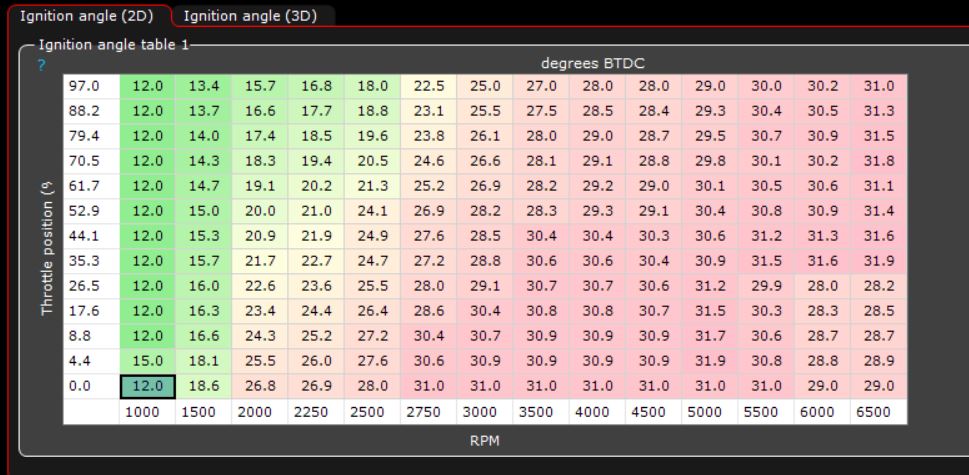 Heres my ign table, 2256cc, web 86b/c 10:1 compression. |
| Mark Henry |
 Nov 24 2017, 03:35 PM Nov 24 2017, 03:35 PM
Post
#14
|
|
that's what I do!                Group: Members Posts: 20,065 Joined: 27-December 02 From: Port Hope, Ontario Member No.: 26 Region Association: Canada |
I got to admit looking at those tables is so confusing, the main reason I've never embraced MS or other data overload systems.
It's a fricken timing curve, not rocket science! My SDS has one value per 250 rpm, that's it. Same could be said about a mechanical dizzy, sure springs but it's a simple curve. I agree with Jake and Mark, idle too low I run 10* and 30*+ is too much advance on a T4, I run 28*. If anything I'd consider retarding the timing a bit as I approached 6000 rpm. One of my tricks when tuning is I have a highway close by that has a long (10km) steady uphill grade and it's divided by a concrete barrier. When in the passing lane you are about 24" from the barrier and the sound bounces so you can really hear the engine mechanicly. I've tested 1.8, 2.0, 2056, 2270, and my 2600 T4's any time I push it to 30* I can hear the ping. I can also see head temps going up. Ping is about the equivalent of hitting your piston top with a ball-peen hammer. Sooner or later it will kill your engine. The chart above "Ideal 2056 Adavance Curve" that might work on a WC engine but I'd never consider it on an aircooled T4. |
| rhodyguy |
 Nov 25 2017, 01:18 PM Nov 25 2017, 01:18 PM
Post
#15
|
|
Chimp Sanctuary NW. Check it out.                Group: Members Posts: 22,192 Joined: 2-March 03 From: Orion's Bell. The BELL! Member No.: 378 Region Association: Galt's Gulch |
You can dial back the total advance with your phone, right? 5 minutes? Give 27* a whirl and see what shakes out.
|
| Mblizzard |
 Nov 25 2017, 05:07 PM Nov 25 2017, 05:07 PM
Post
#16
|
|
Advanced Member     Group: Members Posts: 3,033 Joined: 28-January 13 From: Knoxville Tn Member No.: 15,438 Region Association: South East States |
|
| McMark |
 Nov 26 2017, 07:27 AM Nov 26 2017, 07:27 AM
Post
#17
|
|
914 Freak!                Group: Retired Admin Posts: 20,179 Joined: 13-March 03 From: Grand Rapids, MI Member No.: 419 Region Association: None |
Hey Mike, do you have an IR thermometer? The gun type...
Let the engine warm up a bit, or go for a quick drive, then check the temp of each exhaust pipe, as close to the head as you can. The actual pipes, not the heater boxes. Report back on temps. This is a great quick and dirty way to see if all cylinders are firing evenly or if 1 or 2 cylinders aren't working. It's always amazing to me how even a flat engine can idle when 1/2 the engine isn't working. |
| JamesM |
 Dec 3 2017, 04:41 AM Dec 3 2017, 04:41 AM
Post
#18
|
|
Senior Member    Group: Members Posts: 1,992 Joined: 6-April 06 From: Kearns, UT Member No.: 5,834 Region Association: Intermountain Region |
I got to admit looking at those tables is so confusing, the main reason I've never embraced MS or other data overload systems. It's a fricken timing curve, not rocket science! Watching a three dimensional system operate in real time helps a lot in understanding how it works and in reality it is not much more than a simple timing curve once you know how to read the table. Its really just 10 simple timing curves stacked on top of each other. Take a single horizontal line of the table and that is basically what you have with SDS, a timing setting where the only variable is RPM ( X RPM = Z degrees advance) Like a distributor that only has centrifugal advance. Setting all the horizontal lines up the same produces a table that works exactly like SDS works. The Y axis of the table represents engine load. Depending on how you have the system configured this is usually determined from manifold vacuum but could also be throttle position. So basically every horizontal line is its own independent timing curve and which one is in use at any given time depends on how much load the engine is currently under (or at what position the throttle is). So the top line is basically the ignition curve that is used at wide open throttle, and the bottom line is the timing curve used when the engine is closed throttle under deceleration and everything in between is everything in between, timing curve for 60% throttle, 70% throttle etc. Its sort of like adding vacuum advance and retard cans to a distributor, but magic ones that are able to defy the laws of physics that apply to a vacuum canister in order to provide exactly what you want at all time. Obviously having load dependent timing curves is not necessary for an engine but it does allow you to optimize for all running conditions and do some cool stuff, tricks that you couldn't otherwise do. It can be used to improve drive ability, gas mileage, emissions etc without impacting your WOT power. Fully optimizing a tune to this extent though would require tools not readily available to a home mechanic which is why i question a lot of peoples tables that look like they have been. The table I posted is pretty simple as it is basically the same curve across all loads, the only change i made from there was to not have the timing advance as quickly in the low load/idle area of the map in order to help stabilize the idle but still immediately ramp up the advance as soon as you get on the gas. |
| Mblizzard |
 Dec 3 2017, 06:32 AM Dec 3 2017, 06:32 AM
Post
#19
|
|
Advanced Member     Group: Members Posts: 3,033 Joined: 28-January 13 From: Knoxville Tn Member No.: 15,438 Region Association: South East States |
Hey Mike, do you have an IR thermometer? The gun type... Let the engine warm up a bit, or go for a quick drive, then check the temp of each exhaust pipe, as close to the head as you can. The actual pipes, not the heater boxes. Report back on temps. This is a great quick and dirty way to see if all cylinders are firing evenly or if 1 or 2 cylinders aren't working. It's always amazing to me how even a flat engine can idle when 1/2 the engine isn't working. Will do that. He k for sure. |
| Mblizzard |
 Dec 3 2017, 06:37 AM Dec 3 2017, 06:37 AM
Post
#20
|
|
Advanced Member     Group: Members Posts: 3,033 Joined: 28-January 13 From: Knoxville Tn Member No.: 15,438 Region Association: South East States |
I got to admit looking at those tables is so confusing, the main reason I've never embraced MS or other data overload systems. It's a fricken timing curve, not rocket science! Watching a three dimensional system operate in real time helps a lot in understanding how it works and in reality it is not much more than a simple timing curve once you know how to read the table. Its really just 10 simple timing curves stacked on top of each other. Take a single horizontal line of the table and that is basically what you have with SDS, a timing setting where the only variable is RPM ( X RPM = Z degrees advance) Like a distributor that only has centrifugal advance. Setting all the horizontal lines up the same produces a table that works exactly like SDS works. The Y axis of the table represents engine load. Depending on how you have the system configured this is usually determined from manifold vacuum but could also be throttle position. So basically every horizontal line is its own independent timing curve and which one is in use at any given time depends on how much load the engine is currently under (or at what position the throttle is). So the top line is basically the ignition curve that is used at wide open throttle, and the bottom line is the timing curve used when the engine is closed throttle under deceleration and everything in between is everything in between, timing curve for 60% throttle, 70% throttle etc. Its sort of like adding vacuum advance and retard cans to a distributor, but magic ones that are able to defy the laws of physics that apply to a vacuum canister in order to provide exactly what you want at all time. Obviously having load dependent timing curves is not necessary for an engine but it does allow you to optimize for all running conditions and do some cool stuff, tricks that you couldn't otherwise do. It can be used to improve drive ability, gas mileage, emissions etc without impacting your WOT power. Fully optimizing a tune to this extent though would require tools not readily available to a home mechanic which is why i question a lot of peoples tables that look like they have been. The table I posted is pretty simple as it is basically the same curve across all loads, the only change i made from there was to not have the timing advance as quickly in the low load/idle area of the map in order to help stabilize the idle but still immediately ramp up the advance as soon as you get on the gas. Will sometimes it does seem like data over load it is clear that a system that is responsive to loss has advantages. Using a straight rpm based timing chart was certainty less responsive than the one you provided. |
  |
3 User(s) are reading this topic (3 Guests and 0 Anonymous Users)
0 Members:

|
Lo-Fi Version | Time is now: 25th November 2024 - 06:55 AM |
Invision Power Board
v9.1.4 © 2024 IPS, Inc.








